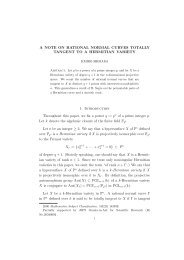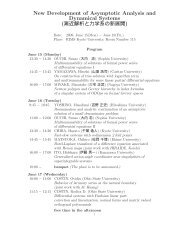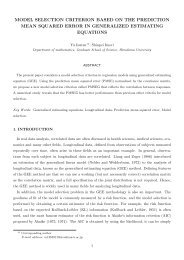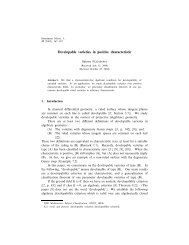LECTURES ON ZARISKI VAN-KAMPEN THEOREM 1. Introduction ...
LECTURES ON ZARISKI VAN-KAMPEN THEOREM 1. Introduction ...
LECTURES ON ZARISKI VAN-KAMPEN THEOREM 1. Introduction ...
Create successful ePaper yourself
Turn your PDF publications into a flip-book with our unique Google optimized e-Paper software.
<strong>LECTURES</strong> <strong>ON</strong> <strong>ZARISKI</strong> <strong>VAN</strong>-<strong>KAMPEN</strong> <strong>THEOREM</strong> 3<br />
0 q<br />
s s s s<br />
✻<br />
u ′ v ′ ✻<br />
u<br />
✻ ✻<br />
u v w<br />
❆<br />
❆<br />
❈<br />
❈<br />
F G<br />
❆<br />
❆<br />
❈ ❈<br />
❆<br />
❆<br />
❆<br />
❆<br />
✲ t ❆ ✲ t ❆✁ ❈ ❈<br />
❈ ❈<br />
✲ t ❈ ❈ ✲<br />
u v<br />
t<br />
0 p u ū u u v w<br />
(1)<br />
(2)<br />
(3)<br />
(4)<br />
Figure 2.2. Proof of Lemma 2.2.<strong>1.</strong><br />
a homotopy H : I × I → X stationary on ∂I from uv to u ′ v ′ by<br />
{<br />
F (2t, s) if 0 ≤ t ≤ 1/2<br />
H(t, s) :=<br />
G(2t − 1,s) if 1/2 ≤ t ≤ <strong>1.</strong><br />
(2) We can construct a homotopy F : I × I → X stationary on ∂I from 0 p u to<br />
u by<br />
{<br />
p<br />
if 0 ≤ t ≤ (1 − s)/2<br />
F (t, s) :=<br />
u(1 − 2(1 − t)/(s + 1)) if (1 − s)/2 ≤ t ≤ <strong>1.</strong><br />
A homotopy stationary on ∂I from u0 p to u can be constructed in a similar way.<br />
(3) We can construct a homotopy F : I × I → X stationary on ∂I from ūu to<br />
0 q by<br />
⎧<br />
⎪⎨ ū(2t)<br />
if 0 ≤ t ≤ (1 − s)/2<br />
F (t, s) := ū(1 − s) =u(s) if (1− s)/2 ≤ t ≤ (1 + s)/2<br />
⎪⎩<br />
u(2t − 1) if (1 + s)/2 ≤ t ≤ <strong>1.</strong><br />
A homotopy stationary on ∂I from uū to 0 p can be constructed in a similar way.<br />
(4) We can construct a homotopy F : I × I → X stationary on ∂I from u(vw)<br />
to u(vw) by<br />
⎧<br />
⎪⎨ u(4t/(2 − s))<br />
if 0 ≤ t ≤ (2 − s)/4<br />
F (t, s) := v(4t + s − 2)<br />
if (2 − s)/4 ≤ t ≤ (3 − s)/4<br />
⎪⎩<br />
w((4t + s − 3)/(s + 1)) if (3 − s)/4 ≤ t ≤ <strong>1.</strong><br />
The following is obvious from the definition:<br />
Lemma 2.2.2. Let u and v be paths on X with u(1) = v(0), and φ : X → Y a<br />
continuous map. Then φ ◦ u and φ ◦ v are paths on Y with (φ ◦ u)(1) = (φ ◦ v)(0)<br />
and they satisfy φ ◦ (uv) =(φ ◦ u)(φ ◦ v).<br />
We fix a point b of X, and call it a base point of X. A path from b to b is<br />
called a loop with the base point b. Let π 1 (X, b) denote the set of homotopy classes<br />
(relative to ∂I) of loops with the base point b. We define a structure of the group<br />
on π 1 (X, b) by<br />
[u] · [v] :=[uv].<br />
From Lemma 2.2.1 (1), this product is well-defined; that is, [uv] does not depend<br />
on the choice of the representatives u of [u] and v of [v]. By Lemma 2.2.1 (4), this






